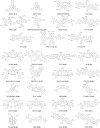Recent Advances in Nonfullerene Acceptor-Based Layer-by-Layer Organic Solar Cells Using a Solution Process
- PMID: 35794317
- PMCID: PMC9443470
- DOI: 10.1002/advs.202201876
Recent Advances in Nonfullerene Acceptor-Based Layer-by-Layer Organic Solar Cells Using a Solution Process
Abstract
Recently, sequential layer-by-layer (LbL) organic solar cells (OSCs) have attracted significant attention owing to their favorable p-i-n vertical phase separation, efficient charge transport/extraction, and potential for lab-to-fab large-scale production, achieving high power conversion efficiencies (PCEs) of over 18%. This review first summarizes recent studies on various approaches to obtain ideal vertical D/A phase separation in nonfullerene acceptor (NFAs)-based LbL OSCs by proper solvent selection, processing additives, protecting solvent treatment, ternary blends, etc. Additionally, the longer exciton diffusion length of NFAs compared with fullerene derivatives, which provides a new scope for further improvement in the performance of LbL OSCs, is been discussed. Large-area device/module production by LbL techniques and device stability issues, including thermal and mechanical stability, are also reviewed. Finally, the current challenges and prospects for further progress toward their eventual commercialization are discussed.
Keywords: layer-by-layer; nonfullerene acceptors; organic photovoltaics; pseudo-planar heterojunction.
© 2022 The Authors. Advanced Science published by Wiley-VCH GmbH.
Conflict of interest statement
The authors declare no conflict of interest.
Figures













References
-
- Kadem B. Y., Al‐hashimi M. K., Hassan A. K., Energy Procedia 2014, 50, 237.
-
- Li Y. W., Xu G. Y., Cui C. H., Li Y. F., Adv. Energy Mater. 2018, 8, 1701791.
-
- Dong S., Jia T., Zhang K., Jing J. H., Huang F., Joule 2020, 4, 2004.
-
- Tang C. W., Appl. Phys. Lett. 1986, 48, 183.
Publication types
Grants and funding
LinkOut - more resources
Full Text Sources
Other Literature Sources
Miscellaneous
